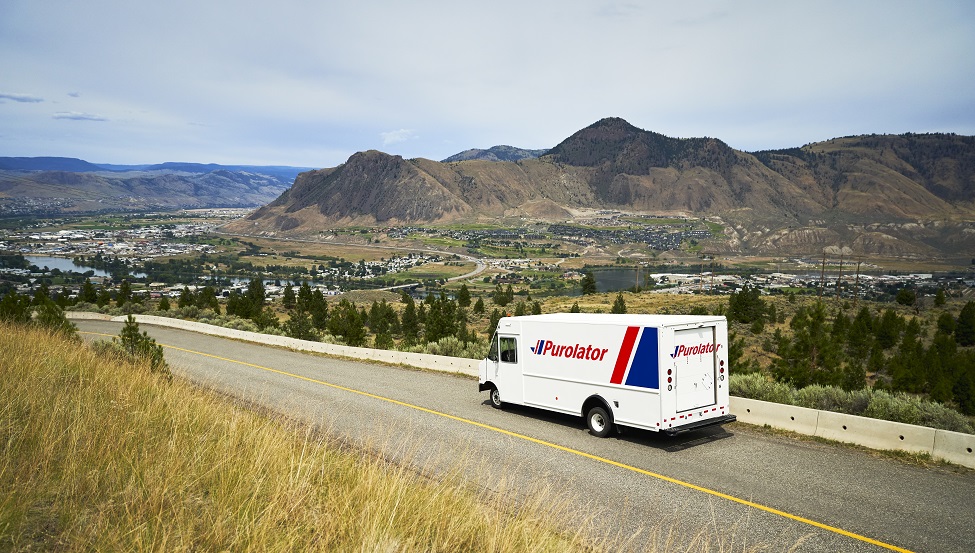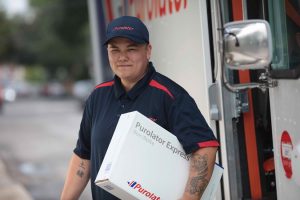
Unlocking Canada’s potential

Post & Parcel speaks to Paul Tessy, Senior Vice President at Purolator International, to hear how harnessing the right mix of network strength and innovation will help customers deliver better in Canada.
Can you give me an overview of Purolator International?
Purolator International is Canada’sa leading Canadian transportation partner for delivery. We have been delivering for Canadians for more than 60 years – to and from and within Canada.
Whether you are looking for courier, ground, express, air or postal delivery, (because we represent Canada Post outside of Canada), we are positioned to bring all of these products to the world.
How is e-commerce in Canada in 2023?
There is not a lot of good news in the headlines nowadays; the global economy is slowing, inflation is at historically high levels and consumer confidence has been hit. Not to mention there is a lot of geopolitical risk flaring up around the world. However, if we narrow our focus, we can still find opportunities to unlock potential and grow. And Canada is one of those key markets.
What’s the potential of the Candian market for logistics companies?
 Canada is a great market to be in – we have a population of 39 million, it is the second largest country in the world by landmass and population density and 70% of the population live within 100 kilometres of the US border.
Canada is a great market to be in – we have a population of 39 million, it is the second largest country in the world by landmass and population density and 70% of the population live within 100 kilometres of the US border.
Canadians love to shop online. There are over 27 million e-commerce users in Canada. JP Morgan found that of 63% of Canadians who made a purchase from an international seller, over 50% came from US sellers. So for the US we are a very important market given our geographical proximity, common culture and language etc However many US and global companies are still underrepresented in Canada.
What challenges are companies typically faced with when trying to work with Canada?
Firstly, geographical coverage is a challenge, especially in rural and remote areas of the North where vehicles need to be equipped to travel distances and in cold weather.
Secondly, cross border delivery can be an obstacle. Most companies use the Hub and Spoke distribution model that works very well for large domestic networks however it is not always optimal for international trade as it isn’t the fastest or most cost-effective method.
Thirdly, consumer demand is another challenge. Amazon has put cost pressure on all delivery providers as consumers now expect fast, reliable, convenient and free delivery.
The final challenge is that traditional b2b is moving into b2c. So many shippers that are only focused on b2b or b2c are finding that the lines are blurring between these two sectors. So traditional b2b companies are now launching their own websites, going direct to consumer and bypassing the typical dealership vendor scenarios, and b2b are also finding their product offerings are insufficient to compete with new b2c entrants.
What’s the best way to access the whole of Canada?
When customers are looking for a partner to deliver in Canda, they need to find one with a broad coverage model. And that is the ability to access the massive geographical territory of Canada. And many delivery providers rely on third parties, and they then require third parties. And this can create an inconsistent final mile delivery experience. So having a large geographical coverage with your own network can be an important advantage for shippers because of that consistency.
What is a more viable alternative to the Hub and Spoke distribution model?
Customers need to find a partner who has a broad product portfolio that includes express, courier, ground, postal delivery, LTL, freight fulfilment, and returns, and also a next flight out mission critical product for the highest level of service demand. This range will allow for flexibility and help overcome any disruption that occurs in the logistics network.
And it is not only about being able to offer these products, but also how these products are bundled together as they move across the border into the customs brokerage process. That bundling is really important for optimisation of service performance and for scale.
How can companies meet consumer demand in Canada?
Companies should look for a partner with a solutions management focus. Industrial engineers and logistics specialists are able to customise networks to gain speed and cost advantage. At Purolator International, when a client comes to us experiencing network challenges in Canada, we assign them a lead industrial engineer. That lead industrial engineer will obtain the customer’s profile data and will look at the cost requirements and the cost constraints. And they will put all that data into a network model using operations research principles. They will use this information to determine the optimal routing, whether it’s air, ground, postal delivery etc . And it’s important because industrial engineers are good at presenting multiple options, so the client can then select the best alternative for their products and for their business.
How is innovation important in meeting consumer demand?
It is really important to address challenges of cost optimisation, speed, access, and convenience with innovation on the consumer front, the middle mile and in the network. On the consumer front shipping companies need to be continually innovating and rolling out new solutions to improve customer experience. For example, in Canada, Purolator International is rolling out 24/7 PUDOQuick Stop kiosks and parcel lockers.
Why is 24-hour access useful for customers?
What we are seeing in Canada, is that 20% of the volumes for consumer delivery are being accessed outside of regular business hours – weekends, evenings and early mornings. We have learnt it is more convenient for consumers to receive items outside of the traditional normal nine to five.
What other ways are you helping customers access services?
We also have mobile quick stop trucks and urban quick stop trucks that are a great addition to our network. We set them up in dense urban high traffic areas where customers can go to pick up and drop off shipments in locations that are closer to their home or work. Other examples of where they are located are train stations or university campuses.
How is Purolator using innovative technology to handle volumes?
Over the last few years what we have been seeing in e-commerce is, the peak is getting peakier. People are buying more and more on selected days for example when it is Mother’s Day or when it is the Christmas holidays. But the answer is not to build large facilities and have them empty during ten months of the year so instead we have mobile dock extensions and inflatable domes in order to increase capacity, agility, and speed, during peak times. This is something we launched during the pandemic to handle the surge is volumes.
We have commissioned a new national hub in Toronto which includes advanced sortation technology, and some innovations that can unload a trailer in under 10 minutes and sort 12,000 parcels per hour. This is 10 times faster than it would be through manual efforts, helping us improve our capacity. We also have an innovation centre in Montreal that tests and then deploys enhancements across the network.
What kind of industries are growing in Canada that logistics companies can tap into?
A few sectors which are really thriving in Canada are retail, e-commerce, industrial and life sciences and healthcare .
In terms of retail, despite the recent slowdown, e-commerce sales have more than doubled in Canada since 2020. Figures increased to 100 billion dollars in 2022.
Healthcare is also a growing sector even in this challenging environment. And we can attribute this to the changing demographics and ageing population. To give you an example, Canada’s medical device market is the eighth largest in the world, and Canada imports 75% of the medical devices used in Canada.
What is the best way of shipping into Canada?
All key trade lanes need to be enabled to access the Canadian market. Many companies are diversifying their production and trade lanes nowadays, and many are moving away from China as well. They’re going into Vietnam or they’re bringing shipments back to North America. In some cases, speed and cost can be gained by consolidating into the US first and then shipping up to Canada.
For companies just starting out who do not have a lot of density into Canada, flying directly into Canada may not be the best method of transit. We advise them to consolidate in the US and Purolator can pick up shipments of goods from LA, New York and Chicago and then onforward into Canada.
What is Purolator doing to ship more sustainably?
 Sustainability is really beginning to change shopping behaviour in Canada. Research has shown 34% of Canadian shoppers are more likely to purchase products or services from a company with a good reputation for environmental responsibility. We have an ambition to become the greenest courier in Canada. A big part of achieving this is by greening our fleet by 2030. We are aiming for 60% of our last mile vehicles used across Canada to be electric and this year alone, we are adding 100 electric vehicles that will be deployed in areas including Toronto, Calgary, Richmond and Quebec City.
Sustainability is really beginning to change shopping behaviour in Canada. Research has shown 34% of Canadian shoppers are more likely to purchase products or services from a company with a good reputation for environmental responsibility. We have an ambition to become the greenest courier in Canada. A big part of achieving this is by greening our fleet by 2030. We are aiming for 60% of our last mile vehicles used across Canada to be electric and this year alone, we are adding 100 electric vehicles that will be deployed in areas including Toronto, Calgary, Richmond and Quebec City.
How is technology changing the face of customer service in Canada?
The use of chat bots, web portals and AI brings a lot of much needed efficiency and simplification to our business. However, in the midst of all this technology, data and customer integration tools, we cannot lose sight of the importance of human interaction. We find that offering an accessible and decentralised customer service department can sometimes deliver a more personalised customer experience. Because we are in the local US markets with the shipper, we understand the specific profile of the client, and are able to take a look at their volumes and notice fluctuations and changes in their profiles, and make on the spot recommendations for routing. This personal touch can’t be underestimated – it is a key business advantage.
How was your experience of presenting at WMX Americas?
The conference in Miami was incredible! After I presented, there was much interest in learning more about the Canadian Market and how Purolator International could support enabling growth. Attendees had no idea Canada had so much potential. Some people said they didn’t know about the challenges of accessing Canada, and maybe they are not working with the right provider. While there are other companies out there operating in Canada, they may not have the same delivery experience, the same speed or the same quality as Purolator International and therefore, it could be affecting your company’s ability to grow.
About Paul
 Paul Tessy joined Purolator as Senior Vice President, International in 2019. He is responsible for leading the company’s international business which includes a significant U.S./Canada cross-border business, global solutions, and value-added logistics services. Paul comes to Purolator from DHL e-Commerce where he held a number of senior roles including CEO, Latin America and Canada, and Senior Vice President, Sales and Customer Service. Prior to his work with DHL, Paul held a variety of global leadership roles with TNT, including President and CEO of TNT Spring Americas.
Paul Tessy joined Purolator as Senior Vice President, International in 2019. He is responsible for leading the company’s international business which includes a significant U.S./Canada cross-border business, global solutions, and value-added logistics services. Paul comes to Purolator from DHL e-Commerce where he held a number of senior roles including CEO, Latin America and Canada, and Senior Vice President, Sales and Customer Service. Prior to his work with DHL, Paul held a variety of global leadership roles with TNT, including President and CEO of TNT Spring Americas.
Paul holds a B.A.Sc., Industrial Engineering from the University of Toronto. He was a member on the Board of Directors of the U.S. Parcel Shipping Association.







